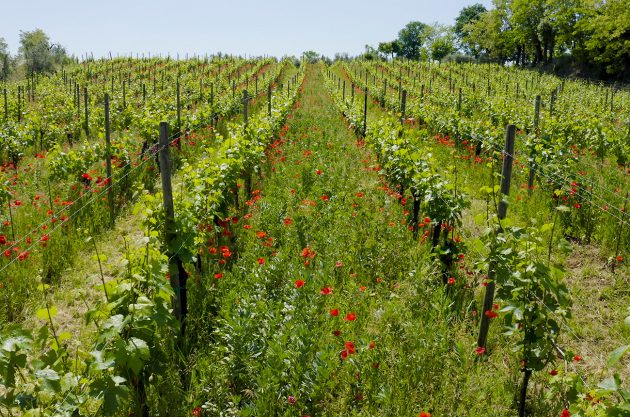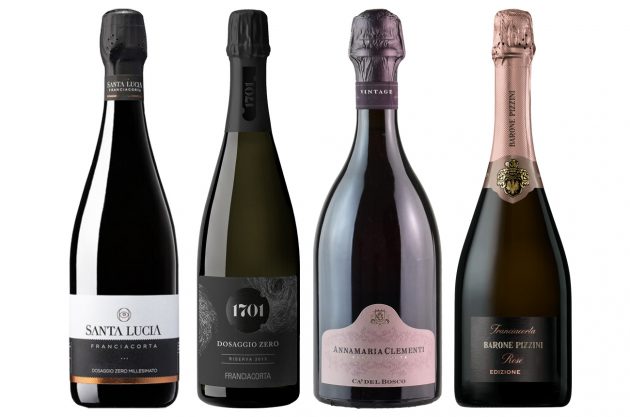Organic viticulture in Franciacorta
As of today, 66.4% of Franciacorta’s vineyards are rated as organic. This figure alone is enough to demonstrate the attention paid to sustainability in this region of premium quality, traditional-method sparkling Italian wines.
According to the growers’ Consortium, of the 2,848ha of DOC or DOCG vineyards, 1,891ha are either in conversion or certified as organically farmed.
This trend towards incorporating organic viticulture is increasing in Franciacorta, together with the producers’ appreciation of the importance of sustainability and a desire to protect the future of the territory.
Franciacorta is thus one of the leading denominations in the world for organic viticulture.
Changing styles and mindsets
Wine styles are progressively changing and adapting, too. To maintain balance in warmer vintages – which are ever more frequent due to climate change – residual sugar in the wines is being progressively reduced.
In 2017, zero dosage (or pas dosé) wines accounted for 2.99% of total production. This figure has risen to 5.1% in 2021. Less dosage means the quality of grapes is high, and therefore less sulphite additions are required.
Many producers are reducing intervention in the vineyard, and quality is sought not only in terms of the organoleptic and analytical profile of the grapes, but also in sustainable production.
Ongoing experiments in this context include:
- Cover-cropping to reduce the presence of machines in the vineyards, promoting an increase of organic matter in the soil.
- Studies in biodiversity, with the aim of conserving and increasing it.

Many winemakers are consolidating their agricultural practices to reduce environmental impact. This includes:
- Devising planting patterns that are appropriate to the soil type, together with prudent management of the areas beneath and in-between vines (cover-cropping, organic matter supply) to help eliminate or drastically reduce the use of fertilisers.
- Practising proper canopy management to reduce the accumulation of moisture around grape bunches and hinder fungal disease.
All of this results in a significant reduction in chemical treatments used to protect the plants. Modern equipment also serves the same purpose, as it is designed to maximise the efficiency of applications.
The Franciacorta Consortium encourages producers, large or small, to give broader meaning to the quality of their wine, aiming not only at organoleptic quality, but also ethical quality.
In fact, every step taken towards this great goal has been supported with activities and projects organised by the Consortium.
Franciacorta wines to try:

Wines tasted and rated by Decanter contributor Aldo Fiordelli
Santa Lucia, Millesimato, 2014 12.5%
From one of the coldest vintages ever in Franciacorta, which was more Continental than Mediterranean. A classic blend with a relatively high proportion of Pinot Noir, above average for Franciacorta. Lime, strawberry, linden tree and lanoline define the layered nose, with dried figs and complexity in depth. Tingling bubbles, crisp acidity, the toasty character melting with a silky texture brings the wine to an oxidative, almondy finish. Very satisfying mouthfeel. 92
1701 Franciacorta, Riserva Pas Dosé, 2013 12.5%
This small estate was the first certified biodynamic winery in Franciacorta. Some of the older vineyards are contained within a very attractive ‘clos’. Candied lemon, honey and patisserie on the nose, complemented by stone fruit (peaches and apricots), giving way to chalk and lemon on the palate. Lifted acidity with exuberant mousse, supporting the richness of fruit and giving delicacy and balance to the wine. 90
Barone Pizzini, Rosé Extra Brut, 2016 12%
Barone Pizzini was the first organic winery in Franciacorta and paves the way for sustainable viticulture. This rosé saignée is based on 70% Pinot Noir and 30% Chardonnay, aged for 40 months on lees. The onion skin colour is bright, the nose complex and deep, with restrained strawberry and raspberry aromas, hints of liquorice and smoky woodland, and toasted bread and butter. The elegant mousse embraces the palate with an assertive buttery aroma and apple juice flavours with a finish that combines acidity and chalkiness. Outstanding balance with good ageing potential. 91
Cà del Bosco, Rosé Riserva, 2008 12.5%
Perhaps one of the best rosé wines ever made in Franciacorta. This 2008 vintage is perfumed with sandalwood and flavoured with wild strawberries, roses and a toasty firecracker minerality. The mousse is incredibly long and fine on the palate with crisp acidity and great balance. This comes from the first year the grapes were washed by machine. A good start indeed. 95
More on Franciacorta:
Franciacorta – understanding the territory
Franciacorta – modernity with history
Lombardy’s fashionable fizz









